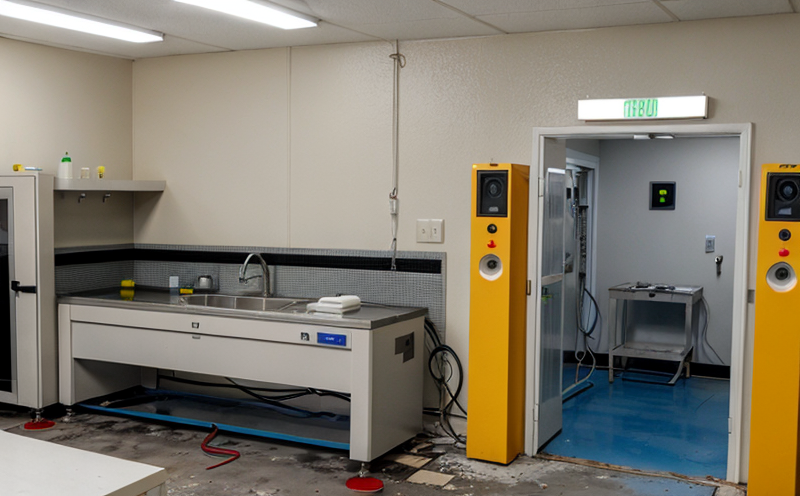ISO 18589-5 Uranium and Plutonium Surface Contamination Analysis
The ISO 18589-5 standard provides a robust framework for the analysis of uranium (U) and plutonium (Pu) surface contamination on various materials used in nuclear facilities. This service is critical for ensuring compliance with international standards, protecting personnel health, and maintaining the integrity of radioactive materials.
The process involves meticulous sample preparation, which includes the use of appropriate solvents to dissolve the contaminants from the surface. The extracted uranium and plutonium are then quantified using advanced analytical techniques such as alpha spectrometry, liquid scintillation counting, or high-resolution mass spectrometry. These methods ensure accurate detection down to the lowest permissible levels specified in international standards.
The acceptance criteria for this service include compliance with ISO 18589-5, which specifies that contamination must be below specified limits for each material type and application. This ensures that the results are reliable and can be trusted for regulatory purposes.
The use of this standard is particularly important in sectors such as nuclear power plants, research reactors, and other facilities handling high-risk radioactive materials. By adhering to ISO 18589-5, these organizations demonstrate their commitment to safety and regulatory compliance.
Our laboratory employs state-of-the-art equipment and experienced personnel to ensure that each analysis is conducted with the highest level of precision. The results are provided in a comprehensive report that includes detailed information on the detection methods used, the specific levels of uranium and plutonium found, and any recommendations for corrective actions if necessary.
Understanding the significance of this service requires an appreciation of its broader implications. In the context of nuclear safety, minimizing surface contamination is crucial to prevent accidental exposure and maintain operational efficiency. This test not only ensures that materials are safe but also supports the ongoing development of safer technologies in the nuclear sector.
Applied Standards
The ISO 18589-5 standard is widely recognized and applied across various sectors that handle radioactive materials. It provides a standardized approach to detecting uranium (U) and plutonium (Pu) surface contamination, ensuring consistency in analytical methods.
- ISO 18589-5: Specifies the methodology for the analysis of uranium and plutonium on surfaces using alpha spectrometry or liquid scintillation counting.
- ASTM E670: Provides guidelines for the sampling and preparation of radioactive materials for analysis, which is essential for accurate contamination testing.
- EN 15342: Offers additional guidance on the measurement of alpha emitters in environmental samples, complementing ISO 18589-5 when dealing with outdoor or atmospheric contamination.
The application of these standards ensures that all tests are conducted under controlled and consistent conditions, leading to reliable results. This consistency is critical for regulatory compliance and the safe handling of radioactive materials in various industries.
Why Choose This Test
- Regulatory Compliance: Adherence to ISO 18589-5 ensures that your facility complies with international standards for nuclear safety and radiation protection.
- Precision and Accuracy: Our laboratory uses advanced analytical techniques to ensure accurate detection of uranium and plutonium contamination down to the lowest permissible levels.
- Expert Personnel: Our team of experienced professionals guarantees that each test is conducted with the highest level of expertise and precision.
- Detailed Reporting: Comprehensive reports are provided, including detailed information on detection methods, contamination levels, and recommendations for corrective actions if necessary.
- Consistency: By using standardized methods as specified in ISO 18589-5, you can ensure that your results are consistent across different testing facilities.
- Risk Management: This test helps identify and mitigate risks associated with surface contamination, ensuring the safety of personnel and the integrity of radioactive materials.
- Continuous Improvement: The insights gained from this test contribute to ongoing improvements in nuclear safety protocols and practices.
Selecting this service ensures that your facility meets stringent international standards, thereby enhancing its reputation for reliability and safety. It also supports the development of safer technologies and practices in the nuclear sector.
Use Cases and Application Examples
| Use Case | Description |
|---|---|
| Nuclear Power Plants | Detection of uranium and plutonium contamination on reactor components to ensure operational safety. |
| Research Reactors | Monitoring surface contamination levels in experimental setups for safe handling of radioactive materials. |
| Radiation Therapy Facilities | Ensuring that radiation therapy equipment is free from contamination, minimizing the risk to patients and staff. |
| Nuclear Fuel Fabrication Facilities | Preventive maintenance by detecting surface contamination on fuel rods before use in reactors. |
| Environmental Monitoring | Detecting trace amounts of uranium and plutonium in the environment to assess potential risks. |
| Nuclear Waste Management Facilities | Verifying that waste materials are free from contamination before disposal, ensuring environmental safety. |
| Research Laboratories Handling Radioactive Materials | Detecting and managing surface contamination in laboratories to maintain safe working conditions. |
The ISO 18589-5 test is essential for facilities that handle radioactive materials, ensuring compliance with international standards and maintaining operational safety. By detecting and managing surface contamination, these organizations contribute to the overall safety of their operations and the environment.





